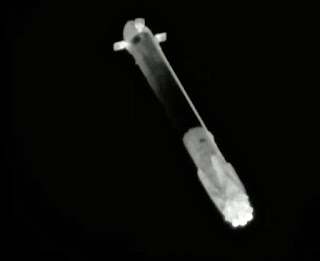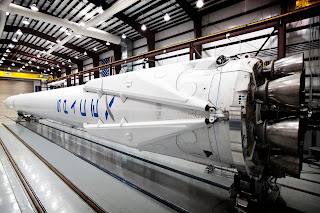How to Land an Orbital Class Rocket...
Hello
all, welcome to yet another blog where I’ll be explaining rocket science and
breaking the concepts into simple principles of physics. Today we shall get to
know how SpaceX’s Falcon9 booster-stage lands with precision. But why only
Falcon9?? I mean orbital rockets have been in existence since the 1950s’ but
there had been no vertically landing rockets until 2015. It may seem surprising
but the concept of vertical landings is pretty old. So, why we didn’t see any
of the vertical landing rockets? Hold on, this article will solve all your
doubts, so without much further ado let’s dive in headfirst.
Lift-off:
 |
| Falcon 9 lifting off |
The Falcon9 at the time of lift-off stands at the height of 70m and weighs about 550,000 kg. The rocket lifts off as all 9 merlin engines are turned on. The booster burns for about 162s before the engines are turned off. We observe MECO (Main Engine Cut-Off) at about 72.3 km of altitude while the vehicle is traveling at about 7800 km/h. The 2nd stage Merlin engine is turned on after separation to achieve orbit. At the same time, the booster stage turns around with the help of cold gas thrusters/nitrogen thrusters and begins the boost back burn.
Boost back burn:
 |
| Booster preparing to land |
There is a certain amount of energy required to get
the 2nd stage into a desired altitude and velocity after which the
booster stage is way off the launchpad. To get back to the launchpad it needs
to cancel out the energy gained and regain the same amount of energy and it is
almost impossible considering the physics of our planet. The booster can never
take enough fuel with it to boost back to the launch site. So instead, SpaceX
planned for landing on a drone ship in the middle of the sea. But why and how
is boost back done anyways? Boost back is done just to cancel out the excess
energy before it re-enters the atmosphere with about 7 times the speed of
sound. Now, here kicks in the entry burn. Without an entry burn, the rocket
will be torn apart mid-air. This burn slows down the rocket for a safe entry
into the atmosphere.
Suicide Burn:
 |
| Suicide burn |
Suicide Burn is a legit thing in Kerbal Space
Program. But apparently, SpaceX doesn’t like it to be called suicide burn. They
call it Hover Slam instead, so we’ll also call it Hover slam 😉
(just kidding). Suicide burn is like parking your car like the protagonist in Rohit
Shetty films but here it's with rockets. The rocket just heads to the landing site full
speed and at a certain point of time before touchdown, the middle merlin engine
is turned on which slows the booster to almost 0 km/h just before touchdown.
Now there is a reason why it is called suicide burn, it is because if you miss
the right time the booster ain’t going to land. If you burn early, you use up
the fuel and smash on the ground, if you burn late the booster still crashes.
Risky stuff indeed!!
Soft Touchdown:
 |
| Iconic touchdown click from the drone ship |
The booster nailing the suicide burn ain’t making no
difference with defective landing legs. The Falcon9 uses 4
hydraulics-controlled legs.
The legs have 4 major components;
·
The deployment arms
·
The legs
·
The pusher
·
The latches
The deployment arms:
 |
| Telescopic deployment arms |
If you have seen a telescope, then you are probably
aware of how it extends forward and retracts in, well, that design is called
telescopic mechanism. The deployment arms have the same mechanism to deploy the
landing legs. Normally, the arms are collapsed, when the booster nails the
suicide burn, then only deployment arms extend as pressurized Helium fills up
the arm. These arms also work as shock absorbers as there’s a heavy chance of
the booster bouncing back after the touchdown.
The legs:
 |
| Legs |
Probably the sexiest legs ever built, these are the parts that physically touch the ground, they have grooves to
house the deployment arms. The legs are normally closed and open with the deployment
of the deployment arms.
The pushers:
 |
| Zoomed-in pic of pushers |
These components are too small and barely visible to us. As you can see in the images that I’ve attached here, the pushers look like small antenna-like structures. Their main purpose of existence is to kick the legs slightly off the body so that gravity and the main arms can do their respective jobs.
The latches:
 |
| Visible triangular latches |
As the name suggests, these small triangular objects stop the legs from deploying during ascent. These open if and only if the booster does a suicide burn.
 |
| The Falcon 9 trajectory |
These 4 major components work hand in hand to make a
near-perfect landing possible. It’s surprising the Falcon-9 booster can land
with a landing accuracy of 10m that’s bonkers considering the booster makes a
comeback from near orbital velocity. Insane engineering spotted.
If
you like our articles then please follow this blog to get
the latest updates directly to you (buttons are available
in the right sidebar or in the bottom menu bar if you are reading this article
on mobile).
To know the basics of the quantum world, astronomy
and space exploration you can check out the book "Through the wormhole" on amazon kindle by Ratnadeep Das Choudhury.
-Ayushman Dash
Chief Space Exploration
Writer
The
Dynamic Frequency













2 Comments
Informative. ��
ReplyDeleteGlad you liked it
Delete